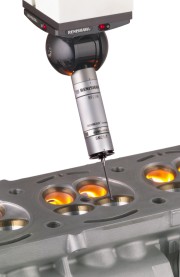| Active or passive scanningPassive scanning technologySimple, compact mechanisms - No motor drives
- No locking mechanism
- No tare system
- No electromagnets
- No electronic damping
- Springs generate contact force which varies with deflection
Adaptive scanning- CMM moves around feature
- Adaptive scanning keeps deflection variation to a minimum
- Small form errors accommodated by sensor mechanism
- Small force variation due to deflection range
BackgroundPassive scanning probes use a simple mechanism to sense stylus deflection in 3 axes. During measurement the springs in the suspended probe mechanism generate a force to match the deflection. This contact force varies with deflection, but it is highly repeatable.The majority of scanning on CMMs involves measuring defined features - precision geometric forms whose size, position and shape is known to lie within a small tolerance band. These features are scanned to check that they fall within the required tolerances. Active scanning systems use their motors to control the contact force between the stylus and the component during the scan. The force is controlled within a narrow range, but there are small variations. The scan involves servoing the stylus carrier over the small range of deflections necessary to accommodate the errors in the form of the feature. Usually these are small - measured in tens of microns. Passive scanning systems use the machine's drives to accommodate surface variations. When performing a scan using a pre-defined scan path, the probe must accommodate form errors. These errors will cause the probe deflection to vary, resulting in slight variations in contact force. If Renishaw adaptive scanning algorithms are used, the scan path is continuously adjusted based on the probe deflection, resulting in a still smaller force variation. The result is a variation in contact force that differs little from that seen with active sensors. Furthermore, sensor calibration ensures that any variation in contact force does not affect measurement results. |